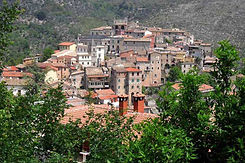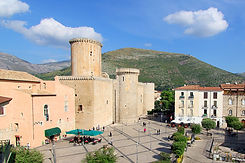

PETALO ROSSO & SURROUNDINGS
History, art, culture, fun & taste ...

LENOLA - A territory of considerable naturalistic value rich in history, traditions, culture, ancient crafts, falling within two natural parks: the Parco dei Monti Ausoni and Lago di Fondi and the Parco dei Monti Aurunci.
Formerly called Ynola, Ynula, Enola. Some scholars attribute the foundation of the city to the Enotri, navigators who arrived in the 15th century BC from the East on our coasts from where they went to the nearby mountains and built small cities to which they gave the name of their ancestors.

Fondi originated well before Rome , connected to it since the III century BC by the Via Appia. In pre-Roman times its territory was inhabited by the Aurunci and subsequently was inhabited by the Volsci. Fundi is mentioned already in 338 BC. The city is mentioned in ancient sources for its important wine production and in particular for the Cecubo, still produced today by local winemakers; exalted by Horace and Martial and described by Pliny the Elder as one of the best of the time.
The city was also the birthplace of some of the most significant intellectuals and artists of the 1900s, such as the poet Libero de Libero, the director Giuseppe De Santis, the painter Domenico Purificato.
Outside the urban perimeter, at the foot of Mount Arcano, stands the abbey of San Magno , built in 522 AD by Sant'Onorato. Treasure chest of history, pictorial art and architecture. Recent restorations have brought to light 12th century frescoes that trace the life of San Benedetto.
Monte San Biagio stretches out on a 133m high hill. along the chain of the Ausoni mountains. It dominates the entire plain of Fondi from Sperlonga to the Canneto river, with Lake Fondi acting as a natural mirror for the enchanting hilly landscape. The suburbs are divided into two: Vallemarina and Villa San Vito, characterized by one of the most important cork oaks in Peninsular Italy at the foot of Monte Calvo; it is a tall forest with cork oak, crossed by numerous paths and easily passable; one of these ends in correspondence with an old oak tree, a hybrid of cork and holm oak which is included in the list of monumental trees in Italy and which represents the symbol of the Cork of San Vito . Ideal place for hiking or biking.

Terracina-Anxur-Terracina : the triple denomination reveals the successive spheres of Etruscan, Volsca and Roman influence. The Roman expansionist crisis of the end of the 6th century BC left free space to the people of the Volsci who occupied it for almost two centuries and changed its name to Anxur. The Romans then established a colony in 329 BC. In 312 Appio Claudio traced the Via Appia. The urbanistic transformations of the Roman city are found in works in opus incertum and reticulatum (theater, walls connecting the monumental complex of Monte S. Angelo, temple of Jupiter, Capitolium); and imperial age, I and II sec. AD (Foro Emiliano, cut of the cliff of Pisco Montano, new Trajan port).
Among the traditional peasant dishes are the bean and broccoli soup, the coratella d'abbacchio. Among those of seafaring tradition, bruschetta with cockles, cuttlefish ink linguine, retunni with petartera. Characteristic sweets: Easter cake and the Christmas casatella. Typical wines: the Moscato di Terracina, the Cesanese and the Aleatico.


Sperlonga is a place that takes its name from the numerous natural caves, in Latin speluncae whose presence characterizes all its coastal coastline, has mythical origins: according to some scholars, in fact, not far from its coasts stood Amiclae, the mysterious city founded by the Laconi . But it was the Romans who discovered it at the end of the republican age creating magnificent residences, attracted by the beauty and mild climate. The merit goes to the emperor Tiberius for having built an imposing villa, which also included a large cave, in which marble works were incorporated, celebrating the deeds of Odysseus.
Typical of the place is the hand cleaning of the trawl fishing net. Even today some fishermen sell the fish they have just caught at the port directly from their boat.

Discovered in 1926 by Baron Carlo Franchetti, they are among the major speleologists of our peninsula and allow you to admire, through a tourist route, the forms of underground karst: majestic and suggestive rooms, stalactites, stalagmites and columns with bizarre shapes, ponds and thunderous waterfalls make the visit to the caves an exciting experience.
A few km from the Caves of Pastena you can visit the museum of agriculture, located in the historic center of Pastena . Furthermore there is the possibility, after the visit, to refresh yourself in the cool of the green landscape and to taste the typical cuisine in the restaurant near the caves or on the village.


